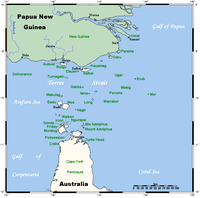
Photo from wikipedia
Diabetes mellitus (DM) affects 11.1% of Aboriginal and Torres Strait Islander adults, more than double the rate of the overall Australian population. Diabetic retinopathy (DR), occurring in up to a… Click to show full abstract
Diabetes mellitus (DM) affects 11.1% of Aboriginal and Torres Strait Islander adults, more than double the rate of the overall Australian population. Diabetic retinopathy (DR), occurring in up to a third of patients with diabetes, is one of the three leading causes of preventable bilateral vision loss in Aboriginal and Torres Strait Islanders (5.2%). Although the recommended rates of annual testing are rarely achieved, DR screening rates have improved in recent years with relative success in meeting 3-yearly testing targets. The majority of DR screening is currently delivered by optometrists and general practitioners (GP), with further referral to ophthalmologists for management. Rural communities are either serviced by a small regional hospital with a visiting ophthalmology service or a rural community health centre with rotating GPs and visiting optometrists and ophthalmologists. This study explores the rate of DR screening over the past five years in the Northern Territory (NT), which has the largest proportion of resident Aboriginal and Torres Strait Islanders compared to the rest of Australia, and discusses the first-hand experience of optometrists, orthoptists, nurses, outreach coordinators, Aboriginal and Torres Strait Islander clinic practice managers and healthcare workers, and ophthalmologists on outreach visits Australia-wide. This discussion on the multi-factorial aspects of DR screening aims to provide an insight into current barriers and offer potential solutions which are applicable not just to the NT, but may also be implemented in regional areas of other Australian states and territories as well. This study was conducted in accordance with the National Statement on Ethical Conduct in Human Research, and consistent with the principles that have their origin in the Declaration of Helsinki. Approval from the Human Research Ethics Committee of the Northern Territory Department of Health and Menzies School of Health Research was obtained prior to its commencement, and it was deemed a Negligible Risk Audit. Patients included in this study were Aboriginal and Torres Strait Islander NT residents over the age of 15 who had a confirmed diagnosis of Type 1 or Type 2 DM and had been reviewed for DR screening by an optometrist or GP at a government-funded rural community health centre across the East Arnhem, Katherine, Top End Central, Top End West and Top End West Arnhem districts between 2015 and 2021. The population data with the annual number of eligible patients and number of patients with DR screening separated into districts is shown in Table 1. The data has not been adjusted for population growth. DR screening included an ocular fundus examination with either fundoscopy or retinal photography. Patient data was obtained as a report from the Primary Care Information System, a government medical electronic health system utilised by the rural and remote health clinics across the NT, with accurate up-to-date information on all residents in the community. The primary outcome measure was the rate of DR screening in each health district. The number of DR screens performed were compared as a percentage to the total eligible Aboriginal and Torres Strait Islander population with DM in each health district. Secondary outcome measures were the frequency of retinal photographs taken and the number of Optometry visits to each health district. Figure 1 shows the rate of eligible patients screened from 2015/16 to 2020/21 across each Top End health district. The overall trend is a rising percentage of patients screened annually in every health district, with a yearly mean growth of 2.1% in the number of eligible patients screened and a mean overall growth of 10.4% from 2015/16 to 2020/21. The most significant growth (P = 0.0063) occurred from 2015/ 16 to 2016/17, likely as a result of increased awareness from the 2016 National Eye Health Survey findings. (4) The slight decrease in 2020/21 correlated with the onset of the COVID pandemic. Figure 2 shows the rate of retinal photos taken in eligible patients from 2015/16 to 2020/21. The overall trend is a drastic decline in the rate of retinal photos taken in every health district, with a mean overall decrease of 10.2%. Table 2 shows the number of optometry visits to the rural community health centres in each NT health district from 2017/18 to 2020/21. There was an overall increase in the number of optometry visits annually in the East Arnhem, Top End West and Top End West Arnhem health districts despite the COVID-19 pandemic. Katherine and Top End Central showed a decline in the number of Optometry visits. Figure 1 and Table 2 show an overall increase in Aboriginal and Torres Strait Islander DR screening compliance and number of optometry clinics to rural and remote regions of the NT.
Journal Title: Clinical and Experimental Optometry
Year Published: 2022
Link to full text (if available)
Share on Social Media: Sign Up to like & get
recommendations!